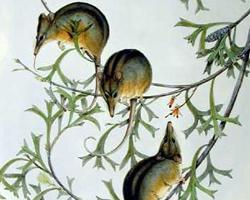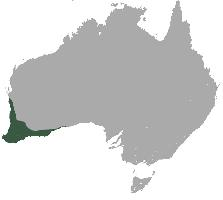
Váhy a míry
| Délka | od 5 do 9 cm |
|---|---|
| Hmotnost | od 8 do 20 g |
Stav ohrožení
| Neohrožen |
Popis zvířete
The Honey Possum, scientifically named Tarsipes rostratus, is a fascinating and unique marsupial native to the southwestern coastal region of Australia. This diminutive creature is the sole member of the family Tarsipedidae, setting it apart from other marsupials in its ecological niche and dietary habits. One of the most remarkable aspects of the Honey Possum is its exclusive nectarivorous diet, which means it feeds primarily on nectar and pollen from flowers. This specialized diet has led to some unique adaptations in its physiology and behavior.Weighing merely 7 to 11 grams and measuring around 6.5 to 9 cm in length, excluding the tail, the Honey Possum has a small, delicate body. Its fur is soft and varies in color from greyish-brown to a more reddish-brown, often blending seamlessly with the Australian bushland. The underside is typically a lighter shade, providing a form of camouflage against predators from both the ground and the air.
The Honey Possum's tail is particularly noteworthy. Long and prehensile, it measures between 7 to 10 cm, effectively doubling the animal's length. The tail is used as a fifth limb, aiding in balance and grip as the possum navigates through the dense foliage in search of food. This arboreal lifestyle is supported by sharp, curved claws which allow the Honey Possum to cling to and climb among flowers and branches with ease.
Adaptations to its nectar-feeding lifestyle are evident in the Honey Possum's anatomy. It possesses a long, pointed snout and a highly specialized tongue, which is brush-tipped and can extend well beyond the length of its snout. This adaptation enables the Honey Possum to efficiently collect nectar and pollen from deep within flowers. Furthermore, its digestive system is uniquely adapted to process this sugary diet, allowing for the efficient absorption of nutrients.
Reproduction in Honey Possums is also intriguing. They have a polygynous mating system, and females can give birth to up to four young after a gestation period of approximately 28 days. The newborns are extremely underdeveloped and tiny, weighing around 5 milligrams. They continue their development in the mother's pouch, which, unlike many other marsupials, lacks a protective closing mechanism. This makes the young vulnerable but reflects the relatively predator-free environment in which they have evolved.
The Honey Possum plays a critical role in its ecosystem as a pollinator. As it moves from flower to flower in search of nectar, it transfers pollen, facilitating the reproduction of various plant species. This ecological service highlights the importance of the Honey Possum in maintaining the biodiversity of its habitat.
Despite its small size and specialized diet, the Honey Possum has adapted well to its environment. However, it faces threats from habitat destruction and fragmentation due to agricultural expansion, urban development, and climate change. Conservation efforts are crucial to ensure the survival of this unique marsupial and the preservation of its natural habitat.
In summary, the Honey Possum is a remarkable example of evolutionary adaptation and ecological specialization. Its existence underscores the complexity of natural ecosystems and the interdependence of species within them.
Mapa výskytu

Nové fotografie zvířat
Top 10 zvířat
- Common house mosquito (Culex pipiens)
- Common cockchafer (Melolontha melolontha)
- Colossal squid (Mesonychoteuthis hamiltoni)
- Hooded merganser (Lophodytes cucullatus)
- Australian box jelly (Chironex fleckeri)
- Fruit fly (Drosophila melanogaster)
- Common reed warbler (Acrocephalus scirpaceus)
- Elephant hawk moth (Deilephila elpenor)
- Moustached guenon (Cercopithecus cephus)
- Diana monkey (Cercopithecus diana)